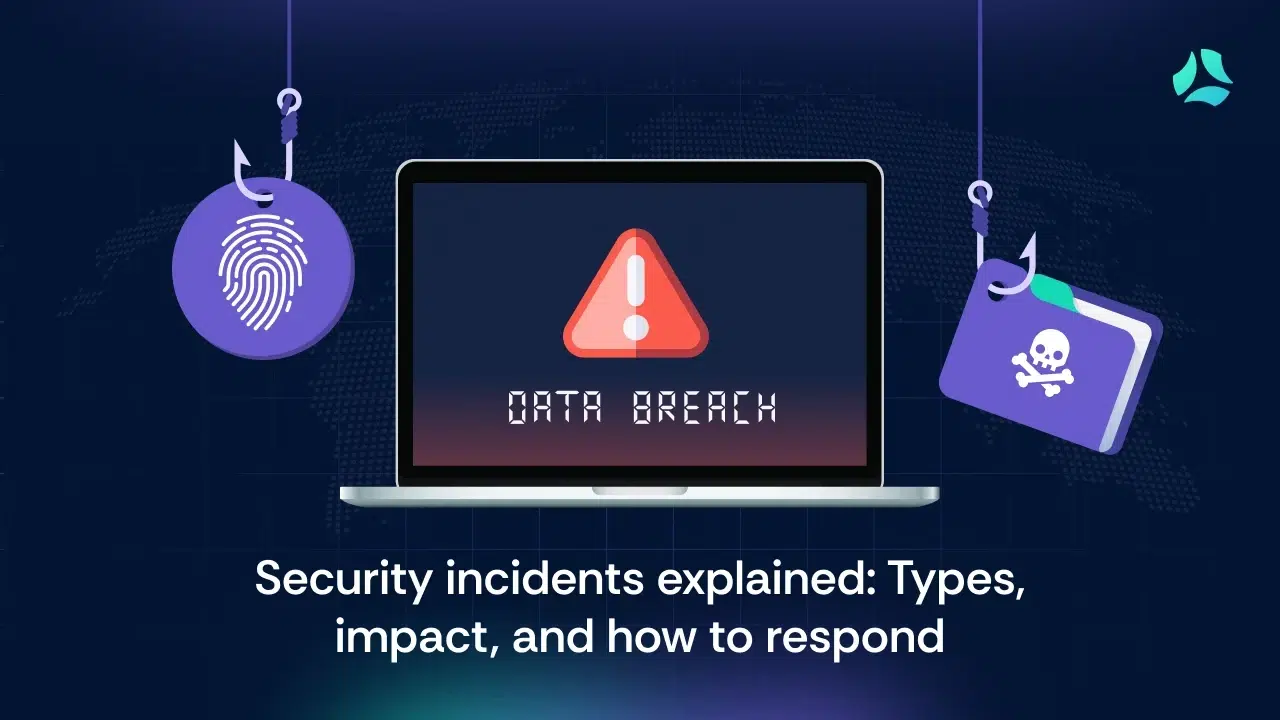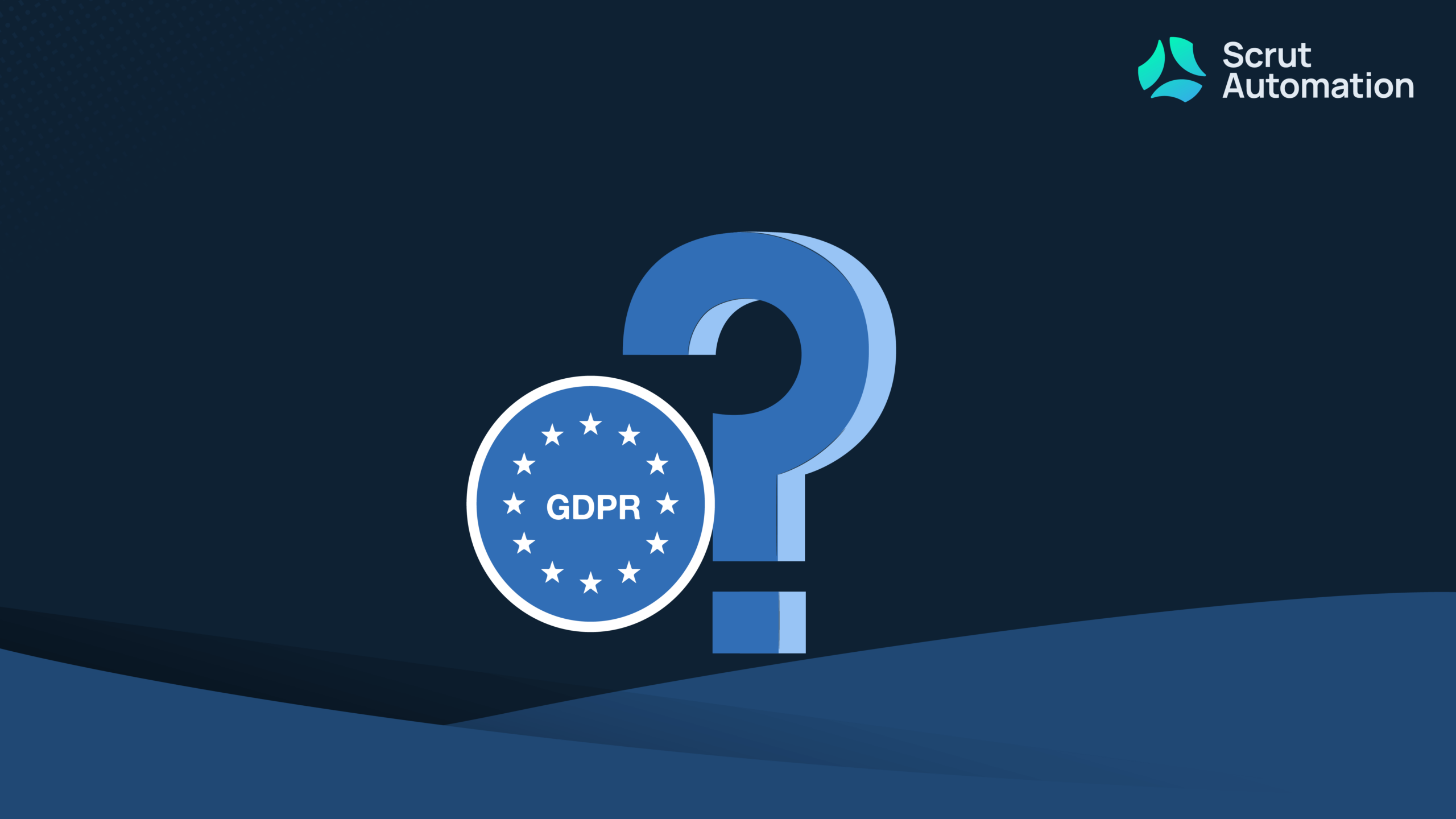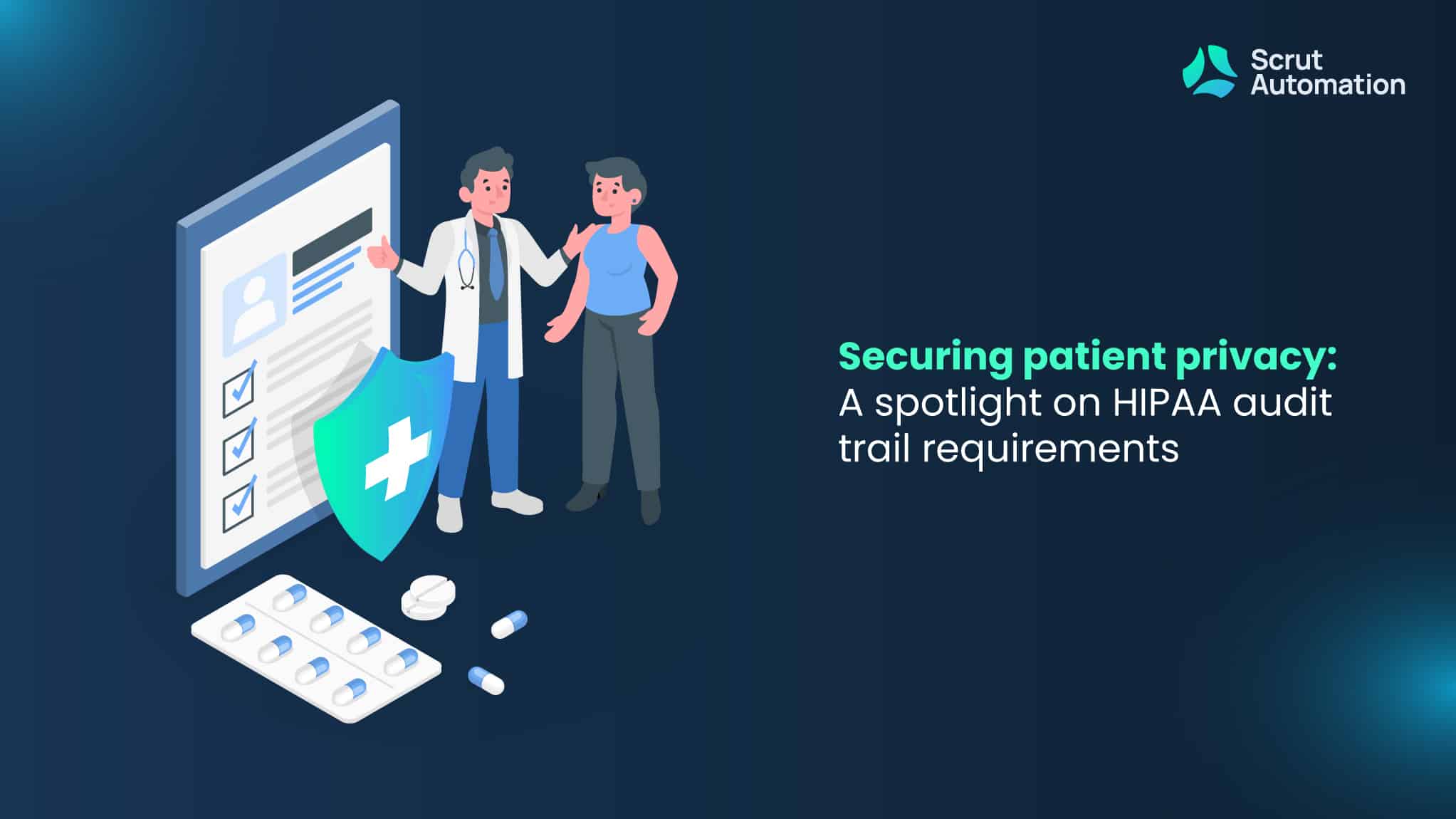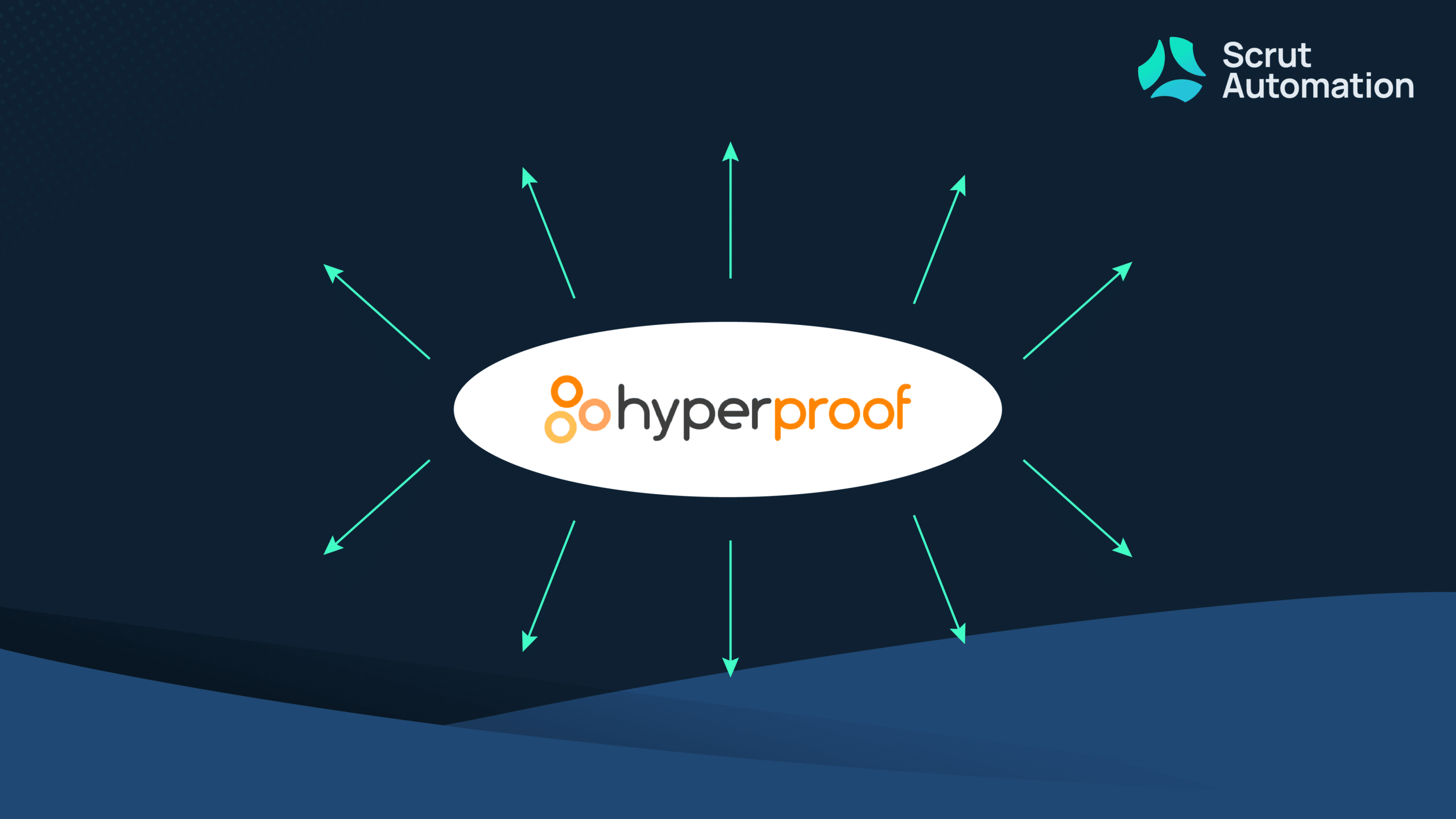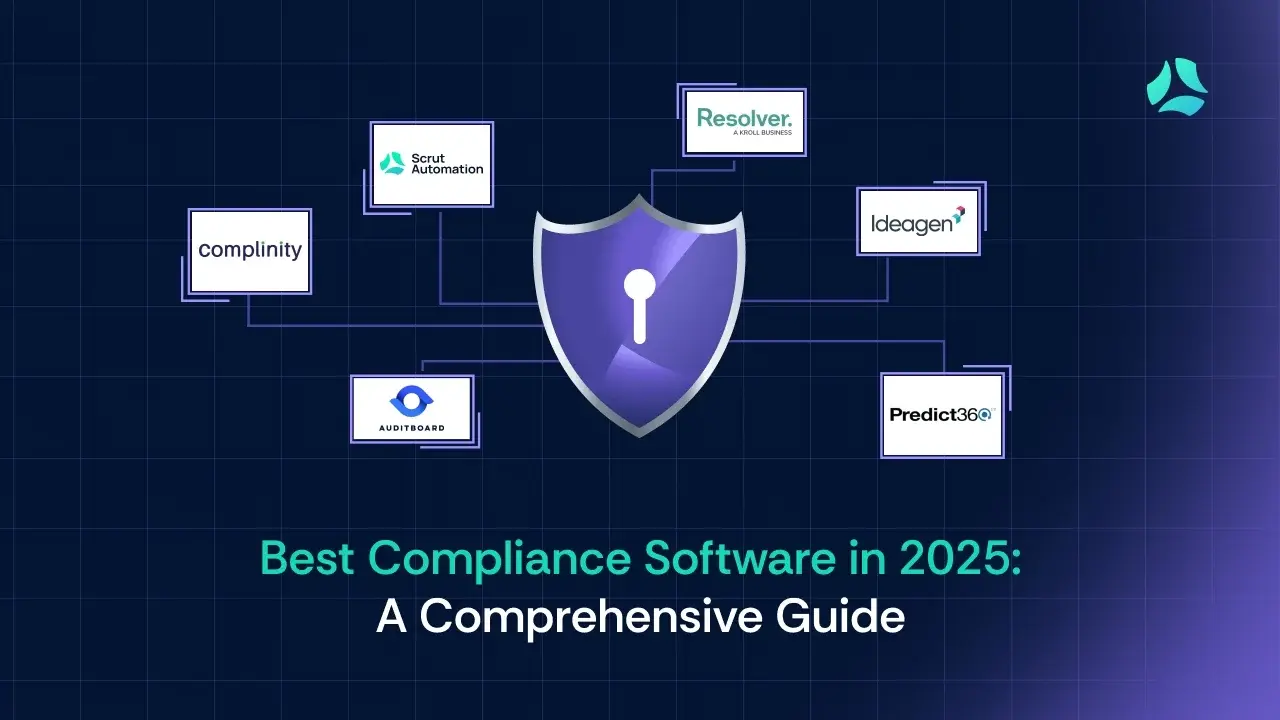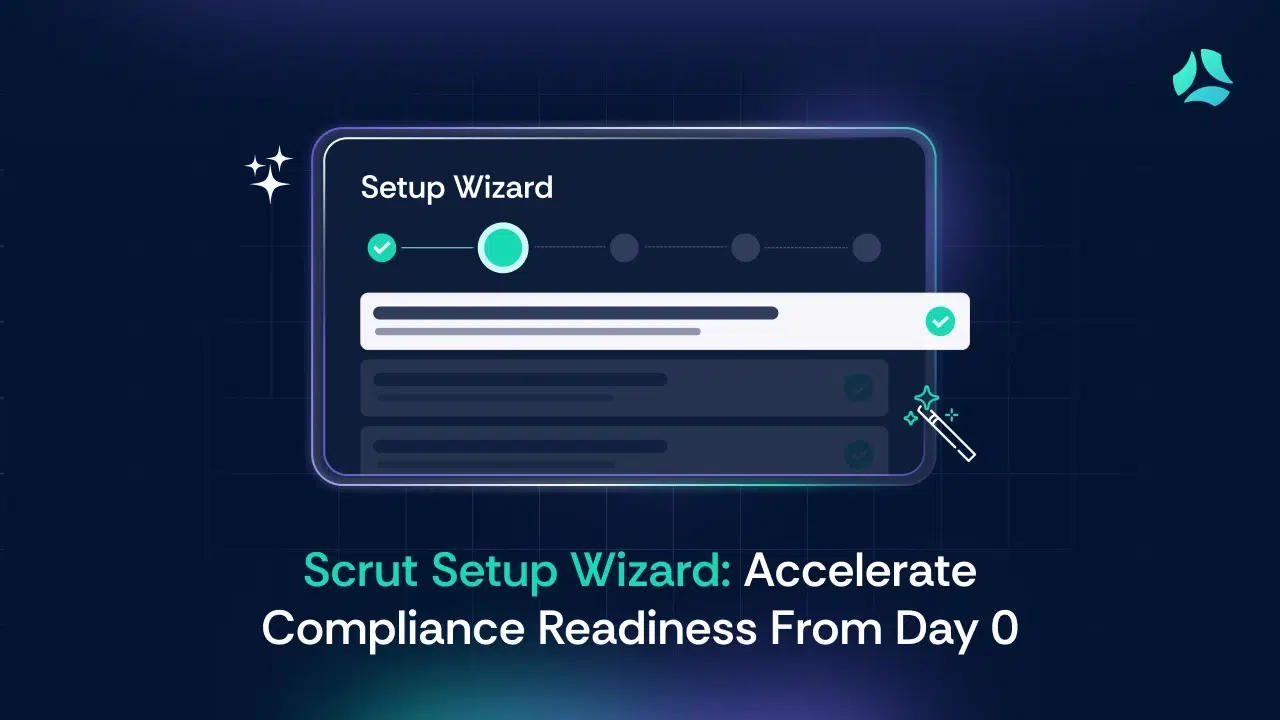In 2024, cyber threats escalated dramatically, with organizations worldwide experiencing an average of 1,636 attacks per week in the second quarter—a 30% increase from the previous year. Notably, North Korea orchestrated the largest cryptocurrency heist to date, stealing approximately $1.5 billion from the ByBit exchange.
Despite these growing threats, the cybersecurity workforce faces a significant shortfall, with 3.5 million unfilled positions globally in 2025. This talent gap leaves organizations more vulnerable to increasingly sophisticated attacks.
This blog delves into the various types of security incidents, offering insights into effective reporting and response strategies. By understanding these facets, readers can better protect their organizations against potential violations and enhance their cybersecurity posture.
What is a Security Incident?
A security incident is any event that compromises the confidentiality, integrity, or availability of an organization’s information, IT systems, or networks. It can range from unauthorized access attempts to full-scale cyberattacks like ransomware or data breaches. Regulatory frameworks such as GDPR, NIS2, and ISO 27001 define security incidents and impose strict reporting and mitigation requirements.
Security incidents are broadly categorized based on their impact and intent. Some incidents, such as accidental data leaks, result from human error, while others, like cyberattacks, are deliberate violations of an organization’s security policies.
Key Characteristics of Security Incident:
1. Unauthorized access – Gaining entry into systems or data without proper permission.
2. Data breaches – Exposing sensitive information, often due to hacking or weak security controls.
3. Disruptions – Interruptions to IT services caused by cyberattacks, malware, or system failures.
4. Policy violations – Internal breaches of security policies, such as employees mishandling confidential data.
Understanding what qualifies as a security incident helps organizations respond effectively, minimize damage, and strengthen their cybersecurity defenses.
A well-structured incident response plan helps organizations detect, report, and mitigate security incidents to minimize damage and enhance cybersecurity defenses.
What are Different Types of Security Incidents?
A security incident is any unauthorized access, violation, or compromise of an organization’s information, IT systems, or networks that can disrupt operations, expose sensitive data, or cause financial and reputational damage. These incidents can be intentional (cyberattacks, insider threats) or unintentional (accidental data leaks, misconfigurations).
Below are the major types of security incidents, along with their definitions, causes, and real-world examples.
1. Unauthorized Access Incidents
Unauthorized access occurs when an individual gains entry into a system, network, or data without proper permission. This could be due to hacking, credential theft, or insider misuse. Unauthorized access can lead to data theft, financial fraud, and severe legal consequences.
Common causes
- Exploiting weak passwords or stolen credentials
- Using hacking tools to bypass authentication
- Insider threats where employees misuse access privileges
Real-world examples
- Yahoo Data Breach (2013): Hackers exploited unpatched security flaws, exposing 3 billion user accounts, making it the largest data breach ever recorded. Stolen data included names, email addresses, hashed passwords, and security questions, which were later sold on the dark web. The breach resulted in severe reputational damage, a $350 million drop in Yahoo’s acquisition price by Verizon, and multiple class-action lawsuits.
- Capital One Breach (2019): A misconfigured firewall within the cloud environment allowed an insider to steal 100 million customer records, exposing Social Security numbers and bank details. The breach led to $80M in regulatory fines and lawsuits.
Impact
Unauthorized access can lead to data theft, financial fraud, espionage, or disruption of critical systems. It compromises confidentiality and can result in regulatory fines, reputational damage, and operational downtime. Attackers may exploit weak passwords, stolen credentials, or system vulnerabilities to gain entry.
Mitigation
Implement strong authentication methods (MFA, biometric verification), enforce least privilege access controls, regularly audit user permissions, and use intrusion detection systems to monitor and block suspicious activities.
2. Data Breaches and Leaks
A data breach is an incident where sensitive, confidential, or protected data is accessed, disclosed, or stolen by an unauthorized party. A data leak occurs when this information is unintentionally exposed due to weak security controls.
Common causes
- Cyberattacks like phishing, malware, or brute force attacks
- Poor security practices leading to misconfigurations
- Insider threats or accidental data exposure
Real-world examples
- Equifax Breach (2017): An unpatched Apache Struts vulnerability allowed attackers to access 147 million consumer records, including Social Security numbers. Equifax agreed to a settlement of at least $575 million, potentially up to $700 million, to address the breach’s consequences.
- Facebook-Cambridge Analytica Scandal (2018): Misuse of user data affected 87 million accounts, leading to a $5 billion FTC fine and heightened scrutiny over data privacy practices.
Impact
Data breaches and leaks expose sensitive information, leading to identity theft, financial losses, legal penalties, and reputational damage. Stolen data can be sold on the dark web or used for fraud, while accidental leaks can violate compliance regulations like GDPR and HIPAA.
Mitigation
Encrypt sensitive data, enforce strict access controls, regularly update security patches, conduct employee training on phishing awareness, and implement data loss prevention (DLP) tools to monitor and restrict unauthorized data sharing.
3. Malware and Ransomware Attacks
Malware (malicious software) is a type of software designed to infect, damage, or gain unauthorized access to systems. It also aids the attacker in stealing, disrupting and manipulating data. Ransomware is a form of malware that steals, and/or encrypts data and demands payment for decryption. These attacks can cause data loss, financial extortion, and operational downtime.
Common types of malware
- Trojan horses: Disguised as legitimate software to infiltrate systems
- Spyware: Secretly collects user data without consent
- Adware: Injects unwanted ads, sometimes containing malicious scripts
Common causes for malware and ransomware attacks
- Phishing emails leading to malicious downloads or credential theft
- Unpatched software vulnerabilities allowing malware exploitation
- Weak or stolen credentials enabling unauthorized system access
- Drive-by downloads from compromised or malicious websites
- Malvertising (malicious ads) spreading malware through legitimate ad networks
- Infected USB drives or external media carrying hidden malware
- Compromised remote desktop (RDP) access used to deploy ransomware
- Third-party software vulnerabilities exploited to inject malware
- Pirated software and cracks containing hidden malware payloads
- Supply chain attacks where infected software updates spread malware
Real-world examples
- WannaCry Ransomware (2017): Affected 200,000 computers across 150 countries, disrupting hospitals, businesses, and governments. It exploited the EternalBlue vulnerability in Windows. The attack was attributed to North Korea.
- NotPetya (2017): A destructive wiper malware attack primarily attributed to Russian actors targeting Ukraine, later spreading globally affecting Maersk, FedEx, and Merck.
Impact
Malware and ransomware attacks can encrypt, steal, or destroy critical data, disrupt operations, and lead to financial extortion, regulatory fines, and reputational damage. Ransomware infections can cripple entire organizations, forcing them to pay large sums to regain access to their data.
Mitigation
Use advanced endpoint protection, enable regular system backups, keep software and security patches updated, implement email filtering to block phishing attempts, and educate employees on safe browsing and suspicious attachments. Deploying zero-trust security models can further limit malware spread.
4. Denial-of-Service (DoS) and Distributed Denial-of-Service (DDoS) Attacks
A Denial-of-Service (DoS) attack floods a network or website with excessive requests, making it unusable for legitimate users. A Distributed Denial-of-Service (DDoS) attack uses multiple compromised devices to amplify the attack, increasing its scale and impact.
Common causes
- Botnets controlled by cyber criminals
- Exploiting vulnerabilities in network protocols (e.g., UDP amplification, SYN floods).
- Extortion attempts where attackers demand ransom to stop the attack
Real-world examples
- Dyn DDoS Attack (2016): A massive botnet attack using Mirai malware, infecting IoT devices (cameras, routers, DVRs). This attack temporarily took down major online services, including Twitter, Netflix, and Reddit, across the U.S. and Europe, highlighting the vulnerability of IoT devices in large-scale cyberattacks.
- GitHub Attack (2018): The largest recorded DDoS attack, peaking at 1.35 Tbps (terabits per second). Used a memcached amplification attack, where unsecured servers were misused to flood GitHub’s infrastructure with massive traffic. Mitigated within minutes by GitHub’s DDoS protection services.
Impact
DoS and DDoS attacks overload servers and networks, making websites, applications, or critical services inaccessible to users. These attacks can disrupt business operations, cause financial losses, and damage customer trust. In severe cases, they can serve as a distraction for larger cyberattacks or data breaches.
Mitigation
Deploy DDoS protection services, use rate limiting and traffic filtering, implement network redundancy and load balancing, and monitor traffic patterns for early detection of unusual spikes. Cloud-based DDoS mitigation solutions can also help absorb large-scale attacks.
5. Insider Threats and Policy Violations
An insider threat occurs when an employee, contractor, or trusted individual misuses their access to compromise security. A policy violation happens when internal rules regarding cybersecurity, data protection, or compliance are not followed, either intentionally or unintentionally.
Common causes
- Negligence (weak passwords, accidental data leaks)
- Disgruntled employees sabotaging or stealing data
- Lack of cybersecurity training leading to careless mistakes
Real-world examples
- Tesla Employee Data Theft (2018): Martin Tripp, a process technician at Tesla’s Gigafactory in Nevada, was accused of hacking the company’s Manufacturing Operating System (MOS) and transferring several gigabytes of confidential data to third parties. Tesla alleged that Tripp’s actions were motivated by dissatisfaction after a job reassignment. The company filed a lawsuit against Tripp, accusing him of sabotage and data theft.
- Sage Group Insider Attack (2016): An employee’s unauthorized use of internal login credentials compromised personal data from approximately 280 UK businesses. The breach led to the arrest of a 32-year-old Sage employee at Heathrow Airport on suspicion of conspiracy to defraud. The incident resulted in financial losses and reputational damage for the company.
Impact
Insider threats and policy violations can lead to data theft, fraud, intellectual property loss, or system sabotage. Whether due to malicious intent or negligence, insiders can bypass security controls, making detection harder. These incidents can result in financial losses, regulatory penalties, and reputational damage.
Mitigation
Enforce role-based access controls (RBAC), implement user activity monitoring, conduct regular security training, and establish strict data handling policies. Deploy behavioral analytics tools to detect unusual activities and set up whistleblower mechanisms to report suspicious behavior.
6. Physical Security Breaches
A physical security breach occurs when unauthorized individuals gain access to secure areas, steal devices, or manipulate physical security controls to access sensitive data.
Common causes
- Tailgating (following an authorized person into a restricted area)
- Theft of devices like laptops or USB drives containing sensitive information
- Unauthorized access to server rooms or data centers
Real-world examples
- Edward Snowden Leak (2013): A former NSA contractor smuggled classified U.S. government data using a USB drive, exposing global surveillance programs run by the U.S. and its allies. The leaks led to diplomatic tensions, legal reforms, and a major debate on privacy and national security.
- Google China Office Break-in (2010): Unauthorized individuals gained access to Google’s Beijing office, raising serious security concerns about corporate espionage and intellectual property theft. The incident occurred amid Google’s conflicts with the Chinese government over cyberattacks targeting human rights activists and censorship policies, eventually leading to Google’s exit from China.
Impact
Physical security breaches can lead to theft of sensitive data, unauthorized access to critical systems, and potential sabotage. Stolen devices or unauthorized facility entry can compromise confidential information, disrupt operations, and create compliance violations under regulations like ISO 27001 and HIPAA.
Mitigation
Implement access control measures such as biometric authentication, security badges, and surveillance systems. Use device encryption and remote wipe capabilities for lost or stolen hardware. Train employees on tailgating risks and enforce strict visitor management policies.
7. Supply Chain Attacks
A supply chain attack targets a third-party vendor or service provider to gain access to multiple companies. Instead of hacking each organization directly, attackers infiltrate software providers, IT services, or hardware suppliers.
Common causes
- Inserting malicious code into software updates
- Exploiting vulnerabilities in third-party services
- Attacking IT vendors to reach their clients
Real-world examples
- SolarWinds Attack (2020): Russian hackers compromised SolarWinds’ Orion software, inserting a backdoor (Sunburst malware) that affected 18,000 organizations, including U.S. government agencies, Fortune 500 companies, and critical infrastructure providers. The breach remained undetected for months, enabling nation-state espionage, data theft, and potential supply chain vulnerabilities, making it one of the most sophisticated cyberattacks in history.
- Kaseya Ransomware Attack (2021): A supply chain attack exploited vulnerabilities in Kaseya’s IT management software, allowing the REvil ransomware group to infect 1,500 businesses worldwide. The attackers encrypted critical systems and demanded a $70 million ransom, crippling managed service providers (MSPs), small businesses, and major enterprises across multiple industries, demonstrating the devastating ripple effects of supply chain attacks.
Impact
Supply chain attacks compromise third-party vendors, software, or service providers to infiltrate multiple organizations. These attacks can lead to widespread data breaches, malware infections, operational disruptions, and financial losses. Since they exploit trusted relationships, they are difficult to detect and can have long-term security implications.
Mitigation
Conduct rigorous vendor security assessments, enforce zero-trust principles, require software integrity checks, and monitor third-party access. Implement secure software development practices (e.g., code signing, vulnerability testing) and regularly update supply chain security policies.
8. Zero-Day Attacks
A zero-day attack exploits an unknown software vulnerability before a fix is available. Since these flaws are not yet publicly disclosed, security teams cannot defend against them until a patch is released.
Common causes
- Attackers discovering security flaws before vendors can patch them
- Government-backed cyber espionage campaigns
- Poor vulnerability management
Real-world examples
- Stuxnet (2010): A highly sophisticated worm designed as a cyberweapon, Stuxnet targeted Iranian nuclear facilities by exploiting unknown Windows vulnerabilities and sabotaging industrial control systems (ICS). It specifically infected Siemens PLCs to alter centrifuge speeds, causing physical destruction of Iran’s nuclear enrichment program. Considered the first cyberattack to cause real-world physical damage, it marked the beginning of cyberwarfare as a tool for geopolitical conflict.
- Microsoft Exchange Server Attack (2021): A zero-day exploit in Microsoft Exchange allowed state-sponsored Chinese hackers (Hafnium group) to compromise over 250,000 email servers worldwide, including businesses, government agencies, and critical infrastructure. Attackers gained full remote control, enabling data theft, espionage, and further malware deployment. The breach forced organizations to rush emergency patches, highlighting the global risks of unpatched vulnerabilities in enterprise software.
Impact
Zero-day attacks exploit previously unknown software vulnerabilities before a patch is available, allowing attackers to gain unauthorized access, steal data, or disrupt operations. These attacks can compromise critical systems, lead to large-scale breaches, and be used for cyber espionage or ransomware deployment.
Mitigation
Use intrusion detection systems (IDS), apply virtual patching through web application firewalls (WAFs), enable automatic software updates, and adopt threat intelligence feeds to identify emerging vulnerabilities. Implement a strong vulnerability management program to minimize exposure.
9. Business Email Compromise (BEC) and Phishing Attacks
A Business Email Compromise (BEC) attack occurs when cybercriminals impersonate executives, employees, or vendors to deceive victims into transferring money or sensitive data. Phishing is a broader category where attackers use fraudulent emails or messages to steal credentials or distribute malware.
Common causes
- Email spoofing and fake domains
- Social engineering (tricking employees into believing the email is real)
- Credential theft via phishing
Real-world examples:
- Facebook and Google Scam (2013-2015): Attackers orchestrated a BEC scam, tricking employees from Facebook and Google into wiring $100 million to fraudulent bank accounts. By impersonating a legitimate hardware vendor (Quanta Computer) using fake invoices and contracts, the scammers exploited human trust rather than technical vulnerabilities. The fraud remained undetected for years, emphasizing the financial risks of sophisticated social engineering attacks.
- Toyota BEC Attack (2019): BEC attack targeted Toyota’s European subsidiary, where a scammer impersonated a trusted business partner and tricked the company into transferring $37 million to fraudulent accounts. The attack exploited email spoofing and social engineering rather than technical vulnerabilities, highlighting the growing financial risks of BEC scams, which have cost businesses billions globally on.
Impact
BEC and phishing attacks trick employees into revealing sensitive data, transferring funds, or granting unauthorized access. These attacks exploit human trust rather than technical vulnerabilities, leading to financial fraud, data breaches, and reputational damage. BEC scams have cost businesses billions globally, affecting organizations of all sizes.
Mitigation
Implement email authentication protocols (DMARC, SPF, DKIM), enforce MFA, conduct regular phishing awareness training, and use AI-powered email security solutions to detect and block suspicious messages. Always verify financial transactions through secondary approvals.
10. Cryptojacking
Cryptojacking is a cyberattack where hackers secretly install malicious scripts on a system to use its computing power for mining cryptocurrency without the owner’s consent. Unlike ransomware, cryptojacking does not disrupt systems but slows down performance and increases power consumption.
Common causes
- Exploiting vulnerabilities in websites and cloud services
- Embedding malicious JavaScript in web pages or ads
- Phishing emails delivering cryptojacking malware
Real-world examples
- Coinhive Malware (2018): A cryptojacking attack that secretly embedded JavaScript-based mining scripts into thousands of websites, using visitors’ CPU power to mine Monero cryptocurrency without their consent. The malware slowed down devices, increased energy consumption, and impacted website performance, affecting government, educational, and media sites worldwide. Coinhive was eventually shut down in 2019, but its impact highlighted the rise of browser-based cryptojacking as a major cybersecurity threat.
- Tesla Cloud Cryptojacking (2018): Hackers exploited Tesla’s unsecured Amazon Web Services (AWS) cloud to run unauthorized cryptocurrency mining operations. By gaining access to Tesla’s Kubernetes console, attackers deployed Monero-mining scripts that operated stealthily, avoiding detection by using low CPU consumption and hiding traffic behind Cloudflare services. The breach highlighted the risks of misconfigured cloud environments, where exposed credentials can lead to resource theft, financial losses, and security vulnerabilities.
Impact
Cryptojacking secretly hijacks computing resources to mine cryptocurrency, slowing down system performance, increasing power consumption, and shortening hardware lifespan. Unlike ransomware, it operates silently, making detection difficult. Large-scale cryptojacking can disrupt enterprise IT infrastructure and lead to higher operational costs.
Mitigation
Use endpoint detection tools, monitor CPU/GPU usage spikes, block unauthorized mining scripts with browser extensions, and apply cloud security controls to detect unusual activity. Regularly update software and enforce strict access controls to prevent exploitation.
11. LLMJacking: Exploiting AI services for cybercrime
LLMJacking, a term first coined by Sysdig, is an emerging cyber threat where attackers exploit stolen cloud credentials to gain unauthorized access to large language model (LLM) services. This tactic fuels an underground market for illicit AI-powered queries, allowing cybercriminals to leverage LLMs for fraudulent activities such as automated phishing, malware development, and disinformation campaigns.
Common causes
- Stolen or leaked cloud credentials: Attackers often exploit weak or stolen login information to gain access to cloud-hosted AI and machine learning services.
- API misuse and misconfigurations: Threat actors take advantage of poorly configured cloud environments or insecure APIs to access otherwise restricted AI models.
- Insider threats and compromised identities: Malicious insiders or compromised user accounts allow attackers legitimate-seeming access to sensitive AI infrastructure.
- Phishing and social engineering: Cybercriminals use tactics such as phishing emails and social engineering to trick employees into handing over credentials, enabling access to cloud AI services..
- Credential-harvesting malware: Malware like Stealc and Vidar can capture cloud credentials directly from infected user devices, providing attackers quick and covert access.
- Exploitation of trust relationships: Attackers exploit legitimate connections between business partners or cloud tenants, bypassing direct authentication requirements.
Real-world examples
- North American consulting firm: In Q2 2024, a threat actor compromised a North American consulting firm and attempted to list available foundational machine learning (ML) models within its cloud-based AI service. The name of the targeted firm is not disclosed in public records. The attacker sought access to restricted models through an API that allowed users to submit justifications for access.
- North America-based technology company: During the same quarter, a similar breach targeted another undisclosed victim, a North America-based technology company. The attacker leveraged the same API to gain unauthorized access to cloud-hosted AI models, likely intending to resell access to other cybercriminals.
Impact
LLMJacking enables adversaries to weaponize AI services for malicious purposes, including:
- Automating phishing and social engineering attacks.
- Enhancing malware development and exploitation techniques.
- Conducting large-scale disinformation campaigns with AI-generated content.
- Exposing proprietary algorithms, business strategies, or sensitive training data due to unauthorized access to AI models.
- Slowing down of legitimate business operations, impacting productivity and user experience as a result of Illicit use of cloud infrastructure.
Mitigation
- Enforce strict access controls and monitor cloud API activity for anomalies.
- Implement multi-factor authentication (MFA) for cloud-based AI services.
- Restrict access to sensitive ML models and use behavioral analytics to detect unauthorized usage.
- Regularly audit API permissions and revoke unnecessary access.
- Deploy behavioural analytics tools to detect anomalous user activities.
How to create an Incident Response Plan?
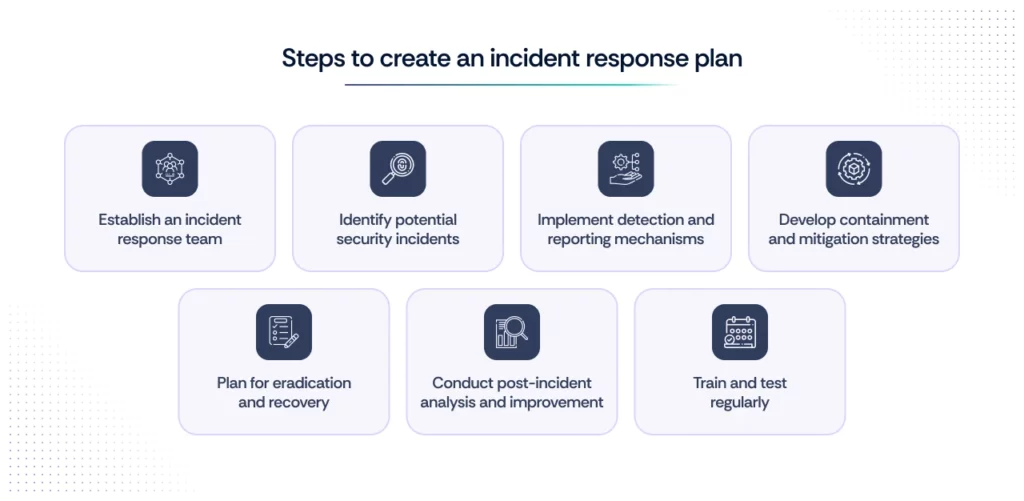
Creating an incident response plan (IRP) ensures an organization can quickly detect, contain, and recover from security incidents while minimizing damage. Here’s how to build an effective plan:
1. Establish an incident response team – Assign roles and responsibilities to IT, security, legal, compliance, and communication teams. Define clear decision-making authority for handling incidents.
2. Identify potential security incidents – Categorize possible threats like malware infections, phishing attacks, insider threats, or data breaches. Develop specific response procedures for each type.
3. Implement detection and reporting mechanisms – Set up monitoring tools, security alerts, and a structured reporting process to detect incidents early. Train employees on how to recognize and report suspicious activities.
4. Develop containment and mitigation strategies – Outline steps to isolate affected systems, block malicious activity, and prevent further damage. Define short-term and long-term containment actions.
5. Plan for eradication and recovery – Establish procedures to eliminate threats, restore affected systems, and ensure data integrity. This includes patching vulnerabilities, securing compromised accounts, and verifying system stability.
6. Conduct post-incident analysis and improvement – After resolving an incident, perform a thorough review to understand what went wrong, identify security gaps, and refine the response plan for future incidents.
7. Train and test regularly – Conduct simulation exercises, tabletop drills, and employee training to ensure the team is prepared and response procedures remain effective.
A well-structured incident response plan helps organizations reduce downtime, limit financial and reputational damage, and strengthen overall cybersecurity defenses.
How Scrut can help organizations manage security incidents?
Scrut helps organizations detect, prevent, and respond to security incidents by providing real-time monitoring, automated alerts, and centralized risk management. With continuous security assessments and compliance tracking, Scrut identifies vulnerabilities before they can be exploited. Its automated risk detection ensures that any anomalies, misconfigurations, or unauthorized access attempts are flagged immediately. Incident reporting is streamlined, allowing teams to log, track, and resolve security events efficiently.
Additionally, Scrut’s compliance automation ensures that security measures align with industry frameworks like ISO 27001, SOC 2, and GDPR, reducing the risk of regulatory violations. By integrating with existing security tools and providing clear remediation steps, Scrut helps businesses strengthen their security posture, minimize threats, and maintain operational resilience.

FAQs
1. What is cyber risk?
Cyber risk refers to the potential for financial loss, disruption, or reputational damage due to cyber threats like data breaches, ransomware, or insider attacks.
2. Is a security incident the same as a security breach?
No. A security incident is any violation of an organization’s security policies, while a security breach occurs when an unauthorized party successfully gains access to sensitive data.
3. What is the main difference between IT security and cybersecurity?
IT security protects all digital and physical IT assets (hardware, networks, systems), while cybersecurity focuses specifically on safeguarding digital assets from cyber threats.
4. How to detect a security incident?
- Unusual user activity – Unexpected access to sensitive data or unauthorized system changes.
- System slowdowns or crashes – Possible malware, ransomware, or DDoS attack.
- Failed login attempts – Repeated failures or access from unknown locations.
- Strange network traffic – Large data transfers or connections to unknown IPs.
- File modifications – Unauthorized changes, deletions, or encryption.
- Increased phishing attempts – A potential precursor to larger attacks.
- Disabled security tools – Antivirus or firewalls shutting off unexpectedly.
5. What are different types of security incidents?
- Unauthorized access – Gaining entry into systems or data without permission.
- Data breaches and leaks – Unauthorized exposure or theft of sensitive information.
- Malware and ransomware – Infecting systems to steal, encrypt, or damage data.
- DoS and DDoS attacks – Overloading networks to disrupt services.
- Insider threats – Employees misusing access intentionally or negligently.
- Physical breaches – Unauthorized entry or theft of secure devices.
- Supply chain attacks – Targeting third-party vendors to infiltrate systems.
- Zero-day attacks – Exploiting unpatched software vulnerabilities.
- BEC and phishing – Deceptive emails tricking users into fraud.
- Cryptojacking – Hijacking systems to mine cryptocurrency secretly.

Megha Thakkar has been weaving words and wrangling technical jargon since 2018. With a knack for simplifying cybersecurity, compliance, AI management systems, and regulatory frameworks, she makes the complex sound refreshingly clear. When she’s not crafting content, Megha is busy baking, embroidering, reading, or coaxing her plants to stay alive—because, much like her writing, her garden thrives on patience. Family always comes first in her world, keeping her grounded and inspired.
